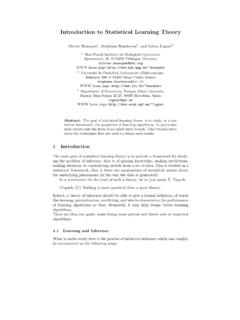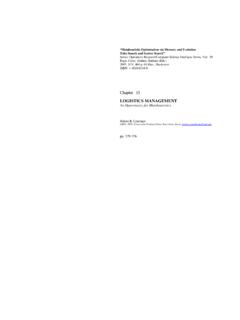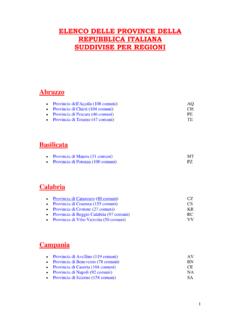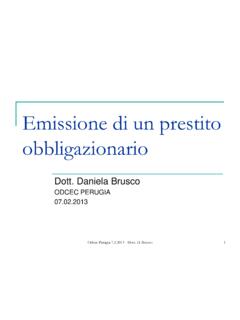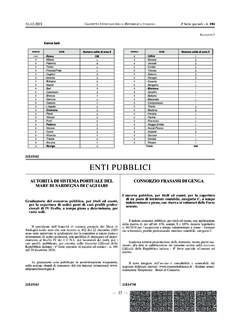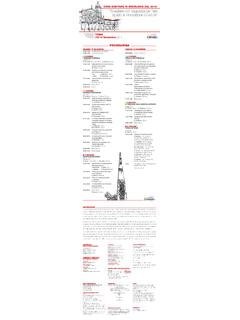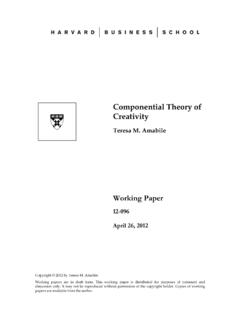Transcription of Introduction to latent variable models - UPF
1 Introduction to latent variable models lecture 1. Francesco Bartolucci Department of Economics, Finance and Statistics University of perugia , IT. [2/24]. Outline latent variables and their use Some example datasets A general formulation of latent variable models The Expectation-Maximization algorithm for maximum likelihood estimation Finite mixture model (with example of application). latent class and latent regression models (with examples of application). latent variables and their use [3/24]. latent variable and their use A latent variable is a variable which is not directly observable and is assumed to affect the response variables (manifest variables).
2 latent variables are typically included in an econometric/statistical model ( latent variable model ) with different aims: . representing the effect of unobservable covariates/factors and then accounting for the unobserved heterogeneity between subjects ( latent variables are used to represent the effect of these unobservable factors).. accounting for measurement errors (the latent variables represent the true outcomes and the manifest variables represent their disturbed versions). latent variables and their use [4/24].. summarizing different measurements of the same (directly). unobservable characteristics ( , quality-of-life), so that sample units may be easily ordered/classified on the basis of these traits (represented by the latent variables).
3 latent variable models have now a wide range of applications, especially in the presence of repeated observations, longitudinal/panel data, and multilevel data These models are typically classified according to: . nature of the response variables (discrete or continuous).. nature of the latent variables (discrete or continuous).. inclusion or not of individual covariates latent variables and their use [5/24]. Most well-known latent variable models Factor analysis model : fundamental tool in multivariate statistic to summarize several (continuous) measurements through a small number of (continuous) latent traits; no covariates are included Item Response Theory models : models for items (categorical responses) measuring a common latent trait assumed to be continuous (or less often discrete) and typically representing an ability or a psychological attitude; the most important IRT model was proposed by Rasch (1961).
4 Typically no covariates are included Generalized linear mixed models (random-effects models ): extension of the class of Generalized linear models (GLM) for continuous or categorical responses which account for unobserved heterogeneity, beyond the effect of observable covariates latent variables and their use [6/24]. Finite mixture model : model , used even for a single response variable , in which subjects are assumed to come from subpopulations having different distributions of the response variables; typically covariates are ruled out latent class model : model for categorical response variables based on a discrete latent variable , the levels of which correspond to latent classes in the population.
5 Typically covariates are ruled out Finite mixture regression model ( latent regression model ): version of the finite mixture (or latent class model ) which includes observable covariates affecting the conditional distribution of the response variables and/or the distribution of the latent variables latent variables and their use [7/24]. models for longitudinal/panel data based on a state-space formulation: models in which the response variables (categorical or continuous) are assumed to depend on a latent process made of continuous latent variables latent Markov models : models for longitudinal data in which the response variables are assumed to depend on an unobservable Markov chain, as in hidden Markov models for time series.
6 Covariates may be included in different ways latent Growth/Curve models : models based on a random effects formulation which are used the study of the evolution of a phenomenon across of time on the basis of longitudinal data;. covariates are typically ruled out latent variables and their use [8/24]. Some example datasets Dataset 1: it consists of 500 observations simulated from a model with 2 components By a finite mixture model we can estimate separate parameters for these components and classify sample units ( model -based clustering). latent variables and their use [9/24]. Dataset 2: it is collected on 216 subjects who responded to T = 4.
7 Items concerning similar social aspects (Goodman, 1974, Biometrika). Data may be represented by a 24-dimensional vector of frequencies for all the response configurations . freq(0000) 42.. freq(0001) 23 . n= .. = .. freq(1111) 20. By a latent class model we can classify subjects in homogeneous clusters on the basis of the tendency measured by the items latent variables and their use [10/24]. Dataset 3: about 1,093 elderly people, admitted in 2003 to 11. nursing homes in Umbria (IT), who responded to 9 items about their health status: Item %. 1 [CC1] Does the patient show problems in recalling what recently happened (5 minutes)?
8 2 [CC2] Does the patient show problems in making decisions regarding tasks of daily life? 3 [CC3] Does the patient have problems in being understood? 4 [ADL1] Does the patient need support in moving to/from lying position, turning side to side and positioning body while in bed? 5 [ADL2] Does the patient need support in moving to/from bed, chair, wheelchair and standing position? 6 [ADL3] Does the patient need support for eating? 7 [ADL4] Does the patient need support for using the toilet room? 8 [SC1] Does the patient show presence of pressure ulcers? 9 [SC2] Does the patient show presence of other ulcers?
9 latent variables and their use [11/24]. Binary responses to items are coded so that 1 is a sign of bad health conditions The available covariates are: . gender (0 = male, 1 = female).. 11 dummies for the nursing homes . age By a latent class regression model we can understand how the covariates affect the probability of belonging to the different latent classes (corresponding to different levels of the health status). General formulation of latent variable models [12/24]. A general formulation of latent variable models The contexts of application dealt with are those of: . observation of different response variables at the same occasion ( item responses).
10 Repeated observations of the same response variable at consecutive occasions (longitudinal/panel data); this is related to the multilevel case in which subjects are collected in clusters Basic notation: . n: number of sample units (or clusters in the multilevel case).. T : number of response variables (or observations of the same response variable ) for each subject . yit: response variable of type t (or at occasion t) for subject i . xit: corresponding column vector of covariates General formulation of latent variable models [13/24]. A latent variable model formulates the conditional distribution of the response vector y i = (yi1.)


